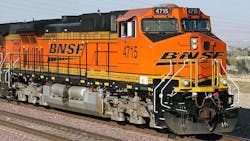Caterpillar, Chevron and BNSF Railway collaborating on Hydrogen demonstration project for Railroad line-haul work
By Rod Walton, EnergyTech Senior Editor
Divisions of engine-generator manufacturer Caterpillar Inc. and energy giant Chevron are joining with freight train firm BNSF Railway Co. to demonstrate the performance of hydrogen fuel cells for locomotives.
Caterpillar’s Progress Rail, Chevron U.S.A. and BNSF announced a memorandum of understanding (MOU) on a demonstration studying the feasibility and performance of hydrogen fuel as a viable alternative for line-haul rail. Hydrogen itself does not emit carbon when burned, but must be produced either by electrolysis--an electrical process separating the hydrogen from water--or steam reforming of methane gas.
The MOU outlined three objectives for the H2 fuel-cell rail study. First, Progress Rail plans to design and build a prototype locomotive, while Chevron will develop the fueling concept and infrastructure. BNSF would then demonstrate the fuel-cell locomotive on its lines for a mutually agreed period of time.
“This technology could one day be a lower-carbon solution for line-haul service, as it has the potential to reduce carbon emissions and remain cost-competitive,” John Lovenburg, vice president of environmental for BNSF, said in a statement.
Earlier this year, Caterpillar and Chevron U.S.A. announced their collaboration around developing hydrogen demonstration projects in the transportation and stationary power generation sectors.
“Caterpillar has made great strides in moving our advanced power technology forward. Our Progress Rail team will leverage that knowledge and experience toward a hydrogen fuel cell locomotive,” said Joe Creed, Caterpillar group president of Energy and Transportation. “Working with Chevron and BNSF will allow us to advance hydrogen technology across the industry.”
Many companies in the energy sector are pursuing experimentation to produce and utilize “green hydrogen” in the fuel sector for both transportation and electric power generation. To be “green,” the hydrogen would have to be produced from electrolysis powered by renewable electricity resources such as wind or solar.
Other forms of hydrogen planning call for producing the H2 from natural gas but then incorporating carbon capture technologies.
Many power generation manufacturers are working on hydrogen-powered studies including a partial mix in their gas-fired turbines and/or engines. Those companies including Mitsubishi Power, Siemens, GE, Ansaldo, MAN Energy Solutions and Cummins.
-- -- --
(Rod Walton, senior editor for EnergyTech, is a 14-year veteran of covering the energy industry both as a newspaper and trade journalist. He can reached at [email protected]).
